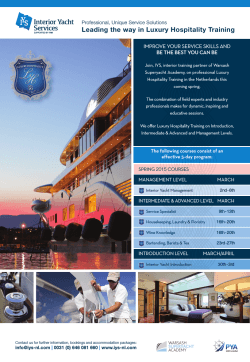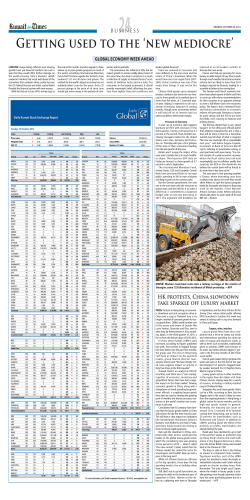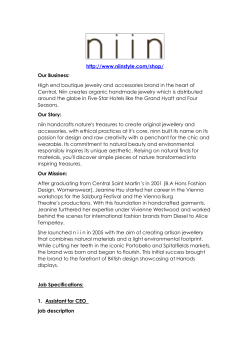
Louis Vuitton and Conservatism: How Luxury Consumption
Louis Vuitton and Conservatism: How Luxury Consumption Influences Political Attitudes YAJIN WANG DEBORAH ROEDDER JOHN Marketing Department Carlson School of Management University of Minnesota Abstract We propose that using luxury products boosts people’s perception of higher social status, which then influences their political attitudes. In two experiments, we find that consumers who use a luxury product express more conservative political views. In addition, we find these effects of luxury use are limited to fiscal political attitudes, and not social political attitudes. These empirical results suggest that luxury consumption has profound effects on the psychological states and attitudes of users, which have been largely ignored in research to date. Louis Vuitton and Conservatism: How Luxury Consumption Influences Political Attitudes One of the biggest trends in consumer behavior over the last two decades is the growth of luxury consumption. During this time, sales of luxury goods have skyrocketed from $80 billion to over $500 billion per year (D’Arpizio 2014) and the number of luxury consumers has more than tripled from 90 million to 330 million (Statista 2014). Across 100 categories of consumer spending, luxury goods have the strongest growth trajectory of any category (Sparshott 2014), and in the next five years, global luxury sales are expected to grow up to 50% faster than the global Gross Domestic Product (D’Arpizio 2014). Once the purview of only the rich, luxury goods are in the hands of more consumers than ever before. Luxury goods are sought after as a means to satisfy a variety of psychological needs, such as signaling status and prestige, as well as compensating for feelings of powerlessness (Rucker, Galinsky, and Dubois 2012; Griskevicius et al. 2007; Han, Nunes, and Dreze 2010; Wilcox, Kim, and Sen 2009). Although this research provides insights into consumer motivations for acquiring luxury goods, little is known about the psychological and behavioral consequences of using luxury goods. Prior research has stopped short of examining what happens when consumers actually use luxury goods—do they see themselves differently, or act differently? Specifically, in this study, we examine whether the mere act of using a luxury product, such as carrying a Prada handbag versus a non-luxury handbag, alters a person’s political attitudes and views. We ask the question: Does using luxury products lead to more politically conservative attitudes? CONCEPTUAL OVERVIEW Luxury goods are products or brands offered at a premium price and quality level (Patrick and Hagtvedt 2008). Luxury brands, in particular, have been defined as being relatively rare and exclusive (Fuchs et al. 2013, Han et al. 2010, Phau and Prendergast 2000; Vigneron and Johnson 2004). Our research focuses on premier luxury brands—such as Prada, Louis Vuitton, and Burberry—that are consistent with these definitions and whose products are widely viewed by consumers as luxury goods (Fuchs et al. 2013). As noted earlier, prior research on luxury goods has examined consumer’s motivations for acquiring these goods, but has not studied the consequences of using luxury goods. My dissertation research addresses this gap by providing an opportunity for individuals to use luxury goods, such as Prada handbags and Burberry scarves, and observing the effects of this experience on user’s psychological states and behaviors. This empirical work has yielded two major effects. First, I found that the experience of using a luxury product boosts people’s perception of social status, and this state of mind triggers selfish behaviors. For example, women who were asked to carry a Prada handbag were less likely to contribute money to a charity than women who were asked to carry a non-luxury handbag. However, when there was an opportunity for people to gain reputation by acting in a more generous way, women who carried the Prada handbag gave more money to a charity than women carrying a non-luxury handbag. Second, I found that luxury consumption reduces an individual’s ability to exert self-control. For example, women who were asked to carry a Prada handbag were less able to exert self-control to resist eating candy than women who where asked to carry a non-luxury handbag. In the current research, I follow up on the finding that luxury consumption can increase a user’s perceived social status, and examine whether these perceptions of higher social status could be linked to changes in political attitudes. Although a direct link between perceived social status and political attitudes has not been established in research to date, several findings hint at such an association. For example, conservatism is found to be associated with values that are connected with higher social status such as authoritarianism (Ray 1979), a preference for tradition, order, and stability (MaCrae and Costa 1997; Roberts et al. 2005), and less agreeableness (Hirsh et al. 2010). Moreover, some earlier work in sociology suggests that that middle-class people tend to be more conservative in their economic attitudes when compared with working-class people (Eysenck 1975, Lipset 1960). Taking these findings into account, we predict that the experience of consuming a luxury product will lead consumers to expouse more conservative (vs. liberal) political attitudes. STUDY 1: LUXURY CONSUMPTION AND CONSERVATISM Method Participants. Fifty seven female students (Mage = 19.86, SD = 1.01) in an introductory business course at a large North American university participated in the study in exchange for partial course credit. Procedure. All participants arrived individually for a study on consumer products. Participants were told that the study was about handbags and that each participant would be given a handbag to try out by carrying it around campus. Afterwards, they would provide feedback about the handbag. The study had two between-subjects conditions. Women were randomly assigned to either carry around a luxury or a control (non-luxury) handbag. Luxury Product Pre-test. To ensure participants had familiarity with luxury brands, a pretest was conducted with a separate sample of 48 female participants (Mage = 20.08, SD = 0.74) from the same sample population as the main study. All participants answered several yes/no questions about ten luxury brands: (1) Have you ever purchased any of the following brands: Gucci, Prada, Louis Vuitton, Burberry, Coach, Tory Burch, Boss, Michael by Michael Kors, Kate Spade, Marc by Marc Jacobs? And (2) Have you ever seen your friends or classmates with products from these brands? Findings showed that 93.8% of the women indicated that they had purchased at least one of these brands, and 97.9% had seen their friends or classmates with products from these brands. Because some of these brands are considered more exclusive than others, we also asked the same two questions again by focusing only on the four high-end luxury brands: Gucci, Prada, Louis Vuitton, and Burberry. Findings showed that 52.1% of women indicated that they had purchased at least one of these four brands, and 87.5% of the women had seen their friends or classmates with products from these brands. Thus, consistent with trends in the luxury goods industry showing that luxury consumption is common among younger consumers, women in our sample population were both highly familiar with and common consumers of luxury brands. Luxury Consumption Experience. Participants were given one of two mid-size handbags. In the luxury condition, participants were given a Prada bag and were explicitly told that this is a brand new Prada bag. In the control condition, participants were given a non-luxury bag similar in size and style to the Prada bag and were told it was a brand new bag from a department store. Whereas the Prada bag retails for $1890, the control bag retails for $75, although no price information was provided to participants. Prada was chosen as the luxury brand because it is not only well-known, but is also highly desirable. Pretesting indicated that our participant population rated Prada an average of 5.55 in desirability on a 1-7 scale. To get a sense of what it’s like to own and use the handbag, each participant was first instructed to imagine that the handbag belonged to her. She was then instructed to put her personal items into the handbag and walk around campus. To ensure that participants would follow a similar walking path, each participant was given instructions to follow a specific path. This included taking a specific elevator to a specified floor, walking through a busy area to a specific coffee shop, and then following the same path to get back. After coming back to the lab about 15 minutes later, each participant was directed to a private room with a computer to fill out a survey about the handbag. This portion of the study contained the dependent measures. Dependent Measures. After participates came back to the lab, they completed a computer based survey. Embedded with many other items, there were two items that assessed their general political attitude. They were (1) “I consider myself to be politically liberal”; (2) “I consider myself to be politically conservative”. Participated rated both items on a 5-point scale from 1 (not at all) to 5 (very much). Items were coded such that higher values indicated conservatism and lower value indicated liberalism. The average of the two items served as the main dependent measure (r = .65, p < .001). Results Consistent with our prediction, we found that participants in the luxury condition perceived themselves to be more conservative (M = 3.71, SD = 1.06) than did participants in the control condition (M = 3.13, SD = .97; t(55) = 2.16, p = .03). In the next study, we examine this effect in more detail. Given the multiple domains of political ideology, we want to assess if luxury consumption has the same effects on both fiscal and social political attitudes. STUDY 2: LUXURY CONSUMPION AND FISCAL POLITICAL ATTITUDES Method Participants and Procedure. Thirty six female students (Mage = 19.97, SD = 1.00) in an introductory business course at a large North American university participated in the study in exchange for partial course credit. The procedure was highly similar to the one described in study 1. Participants again came to the lab individually, were provided with the same cover story, were randomly assigned to carry either a luxury or a control handbag, walked around campus with the handbag for about 15 minutes, and then came back to the lab to complete the dependent measures in a private room. Luxury Consumption Experience. Participants were randomly assigned to receive one of two small handbags (a cross-body clutch). In the luxury condition, participants were given a Louis Vuitton bag and were explicitly told that this is a brand new Louis Vuitton bag. In the control condition, participants were given a non-luxury bag similar in size and style to the Louis Vuitton bag and were told that this is a new bag is from a department store. Whereas the Louis Vuitton bag retails for $730, the control bag retails for $75, although no price information was provided to participants. Louis Vuitton was chosen as the luxury brand because, like Prada, it is not only well-known, but is also highly-desired. Pretesting indicated that our participant population rated Louis Vuitton an average of 5.67 in desirability on a 1-7 scale. As in study 1, participants imagined owning the bag, put their belongings in the bag, and walked around campus with the bag following the same specified path. Dependent Measures. Immediately after participants returned to the lab, they were directed to a private room with a computer to fill out a survey about the handbag. This portion of the study contained the dependent measures. To assess social and fiscal political attitudes, we used items drawn from previous research (Helzer and Pizzarro 2011; Durante, Rea, and Griskevicius 2015). Fiscal political attitudes were assessed through the following three items (α=.66): (1) “The rich should pay a higher tax rate than the middle class” (2) “Business corporations makes too much profit” (3) “Government should ensure that all citizens meet a certain minimum standard of living.” Social political attitude items (α=.58) were: (1) “Abortion is a woman’s right” (2) “Marriage is between a man and a woman” (3) “Stem cell research is moral and can be useful for science” (4) “Marijuana should be legal” (5) “Laws should restrict abortion in all or most cases.” Items were rated on a 1 to 7 scale (1=strongly disagree; 7=strongly agree) and were coded as higher values indicated conservatism and lower values indicated liberalism. Results A repeated measure analysis of variance with type of political attitudes (fiscal vs. social) as a within-subjects factor and handbag (luxury vs. control) as a between-subjects factor revealed a marginally significant two way interaction (F(1, 34)=.3.21, p=.082). As seen in figure 1, regarding fiscal political attitudes, women who used a Louis Vuitton handbag expressed more conservative views (M = 4.38, SD=1.08) than women in the control condition (M=3.52, SD=1.24, t(34)=2.22, p=.033). However, regarding social political attitudes, there was no difference between women carrying a Louis Vuitton handbag (M=2.52, SD=.90) and women carrying the control handbag (M=2.57, SD=1.19, t(34)=.13, p=.89). -------------------------figure 1 about here ------------------------- REFERENCES D’Arpizio, Claudia (2014), “Luxury Goods Worldwide Market Study,” Bain & Company, accessed May 01, 2014, http://www.bain.com/about/press/press-releases/worldwideluxury-goods-continues-double-digit-annual-growth.aspx Durante, Kristina M., Ashely Rae, and Vladas Griskevicus (2013), “The Fluctuating Female Vote: Politics, Religion, and the Ovulatory Cycle,” Psychological Science, 24(6), 100716. Fuchs, Christoph, Emanuela Prandelli, Martin Shreier, and Darren W. Dahl (2013), “All That Is Users Might Not Be Gold: How Labeling Products as User Designed Backfires in the Context of Luxury Fashion Brands,” Journal of Marketing, 77 (September), 75-91. Griskevicius, Vladas, Joshua M. Tybur, Jill M. Sundie, Robert B. Cialdini, Geoffrey F. Miller, and Douglas T. Kenrick (2007), “Blatant Benevolence and Conspicuous Consumption: When Romantic Motives Elicit Strategic Costly Signals,” Journal of Personality and Social Psychology, 93 (1), 85-102. Han, Young Jee, Joseph C. Nunes, and Xavier Drèze (2010), “Signaling Status with Luxury Goods: The Role of Brand Prominence,” Journal of Marketing, 74 (July), 15-30. Helzer, Erik G. and David A. Pizarro (2011), “Dirty Liberals! Reminders of Physical Cleanliness Influence Moral and Political Attitudes,” Psychological Science, 22 (4), 517-522. Hirsh, Jacob B., Colin G DeYoung, Xiaowen Xu, and Jordan B. Perterson (2010), “Compassionate Liberals and Polite Conservatives: Associations of Agreeableness with Political Ideology and Moral Values,” Personality and Social Psychology Bulletin, 36 (5), 655 – 664. McCrae, Robert R. and Costa Jr., Paul T. (1997), “Conceptions and Correlations of Openness to Experience,” In Hogan, Robert, John A. Johnson, and Stephen Briggs (Eds.), Handbook of Personality Psychology (pp. 825-847). San Diego, CA: Academic Press. Patrick Vanessa M. and Henrik Hagtvedt (2009), “Luxury Branding,” The Handbook of Brand Relationships. NY: Society for Consumer Psychology, 267-80. Phau, Ian and Gerard Prendergast (2000), “Consuming Luxury Brands: The Relevance of the ‘Rarity Principle’,” Journal of Brand Management, 7 (5), 366-75. Ray, John J. (1979), “Does Authoritarianism of Personality Go with Conservatism?” Australian Journal of Psychology, 31(1), 9-14. Roberts, Brent W., Oleksandr S. Chernyshenko, Stephen Stark, and Lewis R. Goldberg (2005), “The Structure of Conscientiousness: An Empirical Investigation Based on Seven Major Personality Questionnaires,” Personnel Psychology, 58 (1), 103-139. Rucker, Derek D., Adam D. Galinsky, and David Dubois (2012), “Power and Consumer Behavior: How Power Shapes Who and What Consumer Value,” Journal of Consumer Psychology, 22, 352-68. Sparshott, Jeffrey (2014), “What Products Drove Consumer Spending? Luxury Items, Mostly,” The Wall Street Journal, accessed February 11, 2014, http://blogs.wsj.com/economics/ 2014/01/22/what-products-drove-consumer-spending-luxury-items-mostly/ Statista (2014), “Value of the Personal Luxury Goods Market Worldwide From 1995 to 2013,” The Statistics Portal, accessed September 2014, http://www.statista.com/statistics/266503/value-of-the-personal-luxury-goods-marketworldwide/ Vigneron, Franck and Lester W. Johnson (2004), “Measuring Perceptions of Brand Luxury,” Brand Management, 11 (July), 484-506. Wilcox, Keith, Hyeong Min Kim, and Sankar Sen (2009), “Why Do Consumers Buy Counterfeit Luxury Brands?” Journal of Marketing Research, 46 (April), 247-59. FIGURE 1 EFFECT OF LUXURY CONSUMPTION ON POLITICAL ATTITUDE (STUDY 2) 7.00 Control Handbag Louis VuiEon Handbag Poli%cal A*tudes 6.00 5.00 4.00 3.00 2.00 1.00 Fiscal Politlca A7tude Social Poli<cal A7tude AUTHOR COMMITMENTS We confirm that this work is original, and if accepted, I agree to attend the full workshop and present the work.
© Copyright 2026









